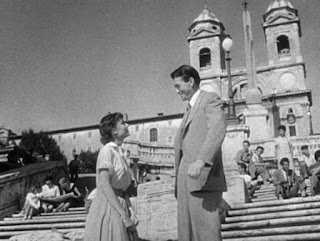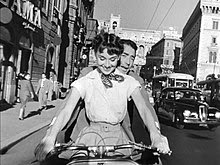This famous silent film short is a result of the cooperation of Luiz Bunel and famous surrealist artist Salvador Dali in the production/direction. And much has been said – even by Dali himself -that nothing in this film was meant to make any sense, still many reviewers and scholars have tried to find some meaning and connection between all scenes throughout the decades. Maybe an attempt to try to find coherence by all means or would there be any sense in the images shown, after all?
The film starts with a tango song in the background and the image of a man sharpening a razor. He goes to a balcony while holding the razor and smoking a cigarette. Then a woman who is sitting down is shown with her eye being cut by the razor at night. Eight years later, a man is shown riding a bicycle on a deserted street in a sunny day. He is wearing unusual clothes and the street looks beautiful. Right afterwards, the woman who had her eye cut a while ago is shown while sitting down on a chair and reading something. The background music changes, the guy on a bicycle pops up again. The woman gets tense, stops reading and goes to the window. The guy on a bicycle is shown again, this time from above. He falls off the bicycle on the sidewalk and the woman goes downstairs to help him.
The woman is shown in her bedroom upstairs again. She is holding a tie and puts it on the bed together with the clothes that belonged to the man who fell off the bicycle. She sits down on a chair and stares at the bed with the man’s clothes on it. Suddenly, a man is shown in the bedroom and he’s looking at one of his own hands and there are ants on it, which seems to be a symbolism of his urge to kill. The images change abruptly, almost in a raw way, and we can now see a man with androgynous features and clothing playing with a human hand with a can while a crowd is around him. Would it mean the use of of human suffering and misery for the entertainment of masses? Would this man be blind or something like that? A policeman comes and disperses the crowd. The man keeps on playing with the human hand with his can and the policeman bents down to collect the hand, puts it on a small box and delivers the hand back to the man.
Both the man and woman in the bedroom follow up this commotion from their window. The man on the street remains there, lonely, holding his small box with the human hand in it until he is hit by a car. The other man by the window seems to be deeply impacted by the event unfolding downstairs. The background tango song is back. The man in the window looks at the woman besides him in a rather scary way and then the shock: He tries to sexually assault the woman by his side even though she refuses his advances. The woman pushes him and runs inside the bedroom and tries to protect herself in any way she can.
Then the man pushes the strings of two pianos and the audience can see two dead donkeys and two priests also being pushed, which weights down on the man heavily. Would it be a representation of the weight of the church and authorities over the back of common citizens? Upon seeing this, the woman leaves the room in horror. The man tries to follow her to no avail and then it is still visible to the audiences the ants on his hand, which might mean his wish to kill and the fact that his bad passions dominated him. Right afterwards the man is suddenly shown laying down on the bed in the same room where he was in the previous scenes.
“Around three in the morning” (as an intertitle says), another man rings the bell and the woman who was previously in the bedroom opens the door. This new man goes straight to the bed where the another man is laying down and he apparently urges him to stand up. The man laying down is quite puzzled and has a submissive attitude. Would this new man be the boss urging his employee to stand up and work, perhaps?
Another intertitle says “Sixteen years before”. Both guys now appear to look the same, even though the submissive guy keeps his oppressed attitude unchanged. There is a messy office desk with torn and dirty papers on it. One guy hands over a book to the other, the image blurs briefly and the submissive man is holding a gun towards the bossy man. He shoots. Would it be the embodiment of the oppressed becoming the oppressor and representing the change of luck of a person in life?
When the shot guy falls, he falls in a place outdoors and we can see the back of a half naked woman, who looks like the woman who was previously in the bedroom. The woman disappears after a short while. Some men are shown in this outdoors place and they find the body of the man who was shot and he is carried by the other man. It seems it was already too late to save his life. Would it be a representation that everything in life will eventually come to an end?
The old bedroom is shown once more. The woman is returning to the bedroom, there is the close up of a small butterfly. The man was waiting for her, which means that the old couple of the bedroom is reunited once more. The man rubs his hand on his lips and we can see that his mouth was deleted from his face. The woman applies some lipstick in her own lips. The man still has no mouth and the woman realizes that her body hair was also gone. She pulls a face on the man and leaves the bedroom again.
It’s windy outside, we can see the man on a beach, the woman walks towards him and the man on the beach is appears to be the same man who has just been seen in the bedroom but in another outfit. He shows his watch to the woman, as if he was reprehending for having arrived late. The woman kisses the man and they embrace. The beach gets muddy and they see some garbage, including old clothes, which look like the clothes that belonged to the man who fell off the bicycle in the beginning of the film. Would it be a representation of leaving the past behind and start a new life?
The couple walks happily on the beach and then another intertitle says “In the spring” and the couple is shown buried in the sand, apparently dead. A strong scene which maybe would mean that life is brief and that, despite all ups and downs, it eventually ends for everyone?
A surrealist work of art gives room for all sorts of interpretations. It can mean nothing and everything, all at the same time, but the imagery always makes people uncomfortable and raises lots of thoughts, which is the intent of the surrealist movement. Definitely it is not a film for everyone and it helps audiences if audiences are open minded about non linear plots.

%20(1929)%20039.jpg)
%20(1929)%20143.jpg)
%20(1929)%20252.jpg)
%20(1929)%20427.jpg)











